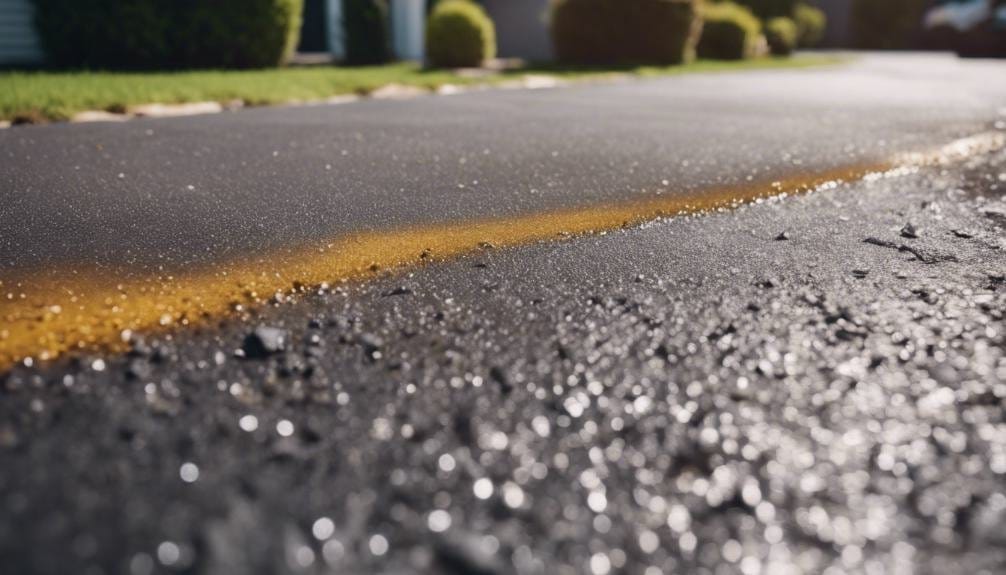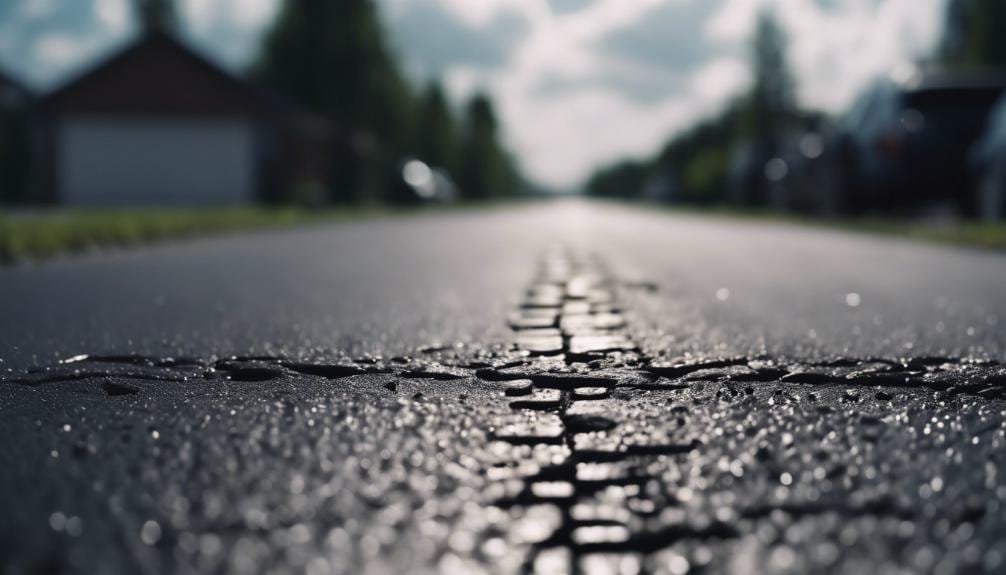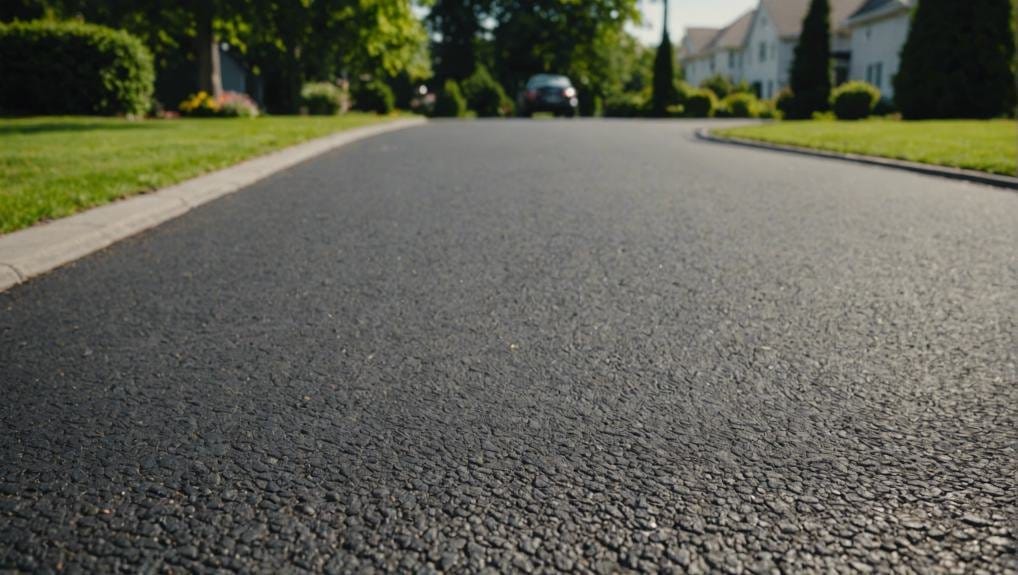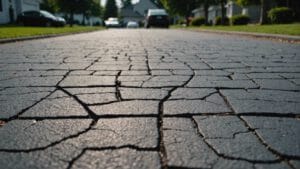To maintain your new asphalt driveway, inspect regularly for cracks, potholes, and standing water. Repair minor cracks promptly using DIY methods; seek professional help for larger ones. Prevent stains with designated cleaners and immediate action. Address water drainage to prevent damage. Apply sealcoating within suggested intervals using professional services for best results. By implementing these maintenance tips, you can enhance your driveway’s longevity and curb appeal. Further details on traffic and weather considerations will optimize your maintenance routine.
Key Takeaways
- Regular visual inspections for cracks, potholes, and water pooling.
- Timely repair of minor cracks to prevent water damage.
- Use appropriate cleaning methods to remove stains promptly.
- Ensure effective water drainage to preserve structural integrity.
- Apply sealcoating every 2-5 years for protection and longevity.
Inspection of Asphalt Surface
Examining your asphalt surface regularly is essential to identifying and addressing any potential issues promptly. Conduct a thorough visual inspection of your driveway for cracks, potholes, and any signs of wear and tear. Pay close attention to areas with standing water as this could indicate poor water drainage, leading to deterioration over time. Additionally, check for any oil spills or leaks that may require cleaning to prevent further damage to the asphalt.
During your inspection, note any changes in color or texture, as these could be indicators of underlying problems that need attention. By being proactive with your visual inspections, you can catch maintenance needs early on and prevent small issues from escalating into larger, costlier repairs. Regular monitoring of your asphalt surface is key to keeping your driveway in excellent condition and prolonging its lifespan.
Crack Repair Techniques
Inspecting your asphalt surface regularly for cracks is essential to maintaining its structural integrity and preventing water penetration that accelerates deterioration. When it comes to crack repairs, timely action is vital. For minor cracks, you can employ DIY repair techniques such as crack fillers available at hardware stores. However, for larger or extensive cracks that pose a risk to the driveway’s stability, it is advisable to seek the expertise of professional contractors who can provide lasting solutions. Identifying crack locations during routine inspections is key to addressing issues promptly. By addressing cracks swiftly, you not only preserve the structural integrity of your driveway but also enhance its appearance and longevity. The table below outlines the importance of crack repairs in driveway maintenance:
| Importance of Crack Repairs |
|---|
| Prevents water penetration that accelerates asphalt deterioration |
| Preserves structural integrity of the driveway |
| Enhances appearance and longevity of the asphalt surface |
Stain Removal Methods

To effectively remove stains from your asphalt driveway, utilize designated cleaners and hand brushes for tackling gasoline or oil spills. Avoid using petroleum solvent solutions, as they can potentially damage the asphalt surface.
Promptly scrub away spills to prevent long-term damage and preserve the appearance of your driveway. Cleaning spills promptly not only maintains the aesthetic appeal but also minimizes deterioration, extending the lifespan of your asphalt surface.
Immediate action is key in preventing deep-seated stains that can be challenging to remove later on. By addressing stains promptly and using appropriate cleaning techniques, you can make sure that your asphalt driveway remains in excellent condition.
Water Drainage Solutions

Effective water drainage is essential for preserving the structural integrity and longevity of your asphalt driveway. Proper water drainage solutions are vital to prevent water accumulation, which can lead to damage and deterioration.
To maintain your driveway, it’s important to address issues such as water seepage and standing water. Implementing good sub-drainage practices guarantees that water flows away from the driveway surface, avoiding spilling and pooling.
By avoiding standing water on your driveway, you can prevent structural issues that may arise from water accumulation. To uphold the quality and appearance of your driveway, consider installing effective drainage systems and maintaining proper water drainage.
Sealcoating Application
Protect your new asphalt driveway from moisture, UV rays, and oil damage by applying sealcoating within the suggested timeframe. Sealcoating acts as a barrier, shielding your driveway from the elements and preventing premature deterioration.
The initial sealcoat should be applied 6-12 months after installation to provide ideal protection. To maintain the integrity and appearance of your driveway, it’s essential to reapply sealcoating every 2-5 years.
Professional services can guarantee proper application techniques and the use of high-quality sealant products, maximizing the benefits of sealcoating. By following the recommended sealing schedule, you can extend the lifespan of your asphalt driveway, reducing surface deterioration and enhancing its curb appeal.
Regular sealcoating not only protects your investment but also maintains the smooth and sleek appearance of your driveway for years to come.
Traffic and Weather Considerations

Consider the impact of traffic and weather conditions on the longevity of your asphalt driveway. Proper maintenance is important to prevent issues like cracks and potholes. Heavy trucks should be kept off the new asphalt to avoid structural stress. Additionally, avoid using the driveway during the hottest part of the day in hot weather to prevent damage.
When heavy rains are expected, make sure that the driveway is clear of any debris to prevent water from pooling, which can lead to deterioration. It’s vital to fill cracks promptly to prevent them from expanding, especially before the weather turns cold. Following these guidelines during the initial days and ongoing asphalt maintenance can greatly enhance the durability of your driveway.
Remember to wait before parking on the new asphalt surface and refrain from driving on it for the recommended period to allow proper curing, making your investment last longer.
Conclusion
To sum up, by following these maintenance tips for your new asphalt driveway, you can guarantee its longevity and durability for years to come.
Just like a well-oiled machine, regular inspections, crack repairs, stain removal, proper water drainage, sealcoating, and considering traffic and weather conditions will keep your driveway running smoothly.
Remember, a little maintenance now can prevent a bumpy road ahead.


